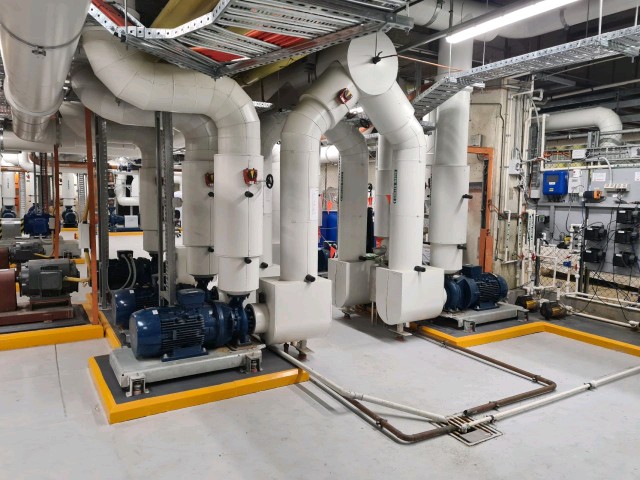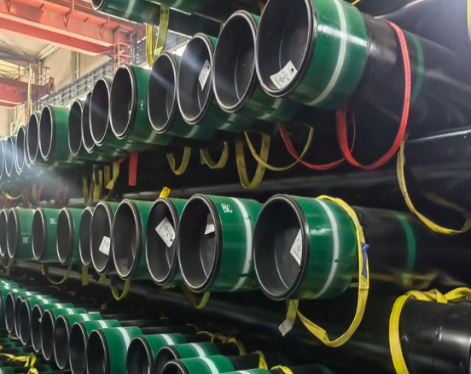Pressure piping refers to all piping subjected to internal or external pressure, regardless of the medium in the pipe. A pressure pipe is a part of a pipeline that is used to convey, distribute, mix, separate, discharge, meter, control and stop fluid flow. An assembly consisting of pipes, fittings, flanges, bolted connections, gaskets, valves, other components or pressure parts and supports.
Classification of pressure pipes:
Pipes have a wide range of uses, a wide variety, different characteristics and pipes used in different fields, and their classification methods are also different. According to the internal pressure of the pipeline, it can be divided into vacuum pipeline, low pressure pipeline, medium pressure pipeline, high pressure pipeline and ultra high pressure pipeline;
Classification of pressure pipes
1. According to the different conveying medium, it is divided into steam pipeline, gas pipeline, process pipeline, etc., among which the process pipeline is named as various pipelines according to the name of the conveying medium;
2. According to the material, there are alloy steel pipes, stainless steel pipes, carbon steel pipes, non-ferrous metal pipes, non-metallic pipes and clad pipe, etc. For example, composite material pipes include metal composite pipes, non-metal composite pipes, metal and non-metal composite pipes .
3. According to the use of pressure pipelines, they are divided into: long-distance pipelines, industrial pipelines, and public pipelines.
(1) Long-distance pipeline:It refers to the medium (oil, gas, etc.) used to transport commodities between production places, storage warehouses, and user units. And across provinces and cities, through and across (rivers, roads, etc.), long-distance (generally greater than 50KM) pipelines with pressurized pump stations in the middle.
(2) Industrial pipes:Refers to the process pipelines, public engineering pipelines and other auxiliary pipelines used to transport process media belonging to enterprises and institutions
(3) Public pipeline:It refers to gas pipelines and heat pipelines used for public utilities or civilian use in cities, towns, industrial factories, mines and living areas.

Composition of pressure piping
Pressure pipes are mainly used to transport media (including gas, liquid and slurry), and some pipes can also be used for storage and heat exchange of media. The basic working principle is to use the pressure of the medium itself or the external power to make the transported medium flow from the beginning to the end.
The structure and composition of the pressure pipeline vary depending on the purpose and function of the pipeline. Generally, it is composed of three parts: pipeline components, pipeline supports, safety devices and auxiliary facilities.
Pressure piping characteristics
1. The pressure pipeline is a system, which is interrelated and affects each other, and it affects the whole body.
2. The length-to-diameter ratio of the pressure pipe is very large, and it is very easy to lose stability, and the stress situation is more complicated than that of the pressure vessel. The fluid flow state in the pressure pipeline is complex, the buffer space is small, and the frequency of changing working conditions is higher than that of the pressure vessel (such as high temperature, high pressure, low temperature, low pressure, displacement deformation, wind, snow, earthquake, etc. may affect the force of the pressure pipeline).
3. There are many types of pipeline components and pipeline supports, each material has its own characteristics and specific technical requirements, and the selection of materials is complicated.
4. There are more possible leakage points on the pipeline than on the pressure vessel, and there are usually five places for only one valve.
5. There are many types and quantities of pressure pipes, and there are many links in design, manufacture, installation, inspection, and application management, which are quite different from pressure vessels.
Causes of accidents in pressure pipelines
1. Design problem: Design without qualification, especially the design of technical transformation projects of small and medium-sized factories is often designed by itself, and the design plan has not been filed by the relevant department.
2. Weld seam defects: unlicensed welders perform welding; welding does not open the groove, the weld seam is not penetrated, the weld seam is seriously misaligned or other defects exceeding the standard cause the weld seam strength to be low. Exceeding the standard welding defects were detected without inspection and non-destructive testing after welding.
3. Material defects: wrong material selection or modification; poor material quality, heavy leather and other defects.
4. Valve body and flange defects: valve failure and wear, valve body and flange materials do not meet the requirements, valve nominal pressure and application range are not selected correctly.
5. Insufficient safety distance: The distance between the pressure pipeline and other facilities is not in compliance with the regulations, and the safety distance between the pressure pipeline and living facilities is insufficient.
6. Lack of safety awareness and safety knowledge: Ideologically, the safety awareness of pressure pipelines is weak, and the safety knowledge of media related to pressure pipelines (such as liquefied petroleum gas) is poor.
7. Illegal operation: There is no safe operation system or there is a system that is not strictly implemented.
8. Corrosion: Corrosion is caused by pressure pipes being overdue in service, and no in-use inspections have been conducted to assess the safety status.
Conclusion
The operation of pressure pipelines is generally carried out outdoors, and the laying methods include overhead, along the ground, buried, and often even high-altitude operations. The environmental conditions are poor and the quality control requirements are high. Since the quality control links are interlocking and organically combined, a slight negligence in one link will lead to quality problems. Welding is a key work in the construction of pressure pipelines. Its quality and efficiency directly affect the safe operation of the project and the manufacturing period, so the control of process quality is more important. According to the construction requirements of pressure pipelines, management must be strengthened in terms of personnel, equipment, materials, process documents and the environment. Only by taking strict measures in a targeted manner can we ensure the welding quality of pressure pipes and ensure the realization of high-quality welding projects.
Classification of pressure pipes:
Pipes have a wide range of uses, a wide variety, different characteristics and pipes used in different fields, and their classification methods are also different. According to the internal pressure of the pipeline, it can be divided into vacuum pipeline, low pressure pipeline, medium pressure pipeline, high pressure pipeline and ultra high pressure pipeline;
| Vacuum pipeline | P<0MPa |
| Low pressure pipeline | 0≤P≤1.6MPa |
| Medium pressure pipeline | 1.6 |
| High pressure pipeline | 10 |
| Ultra-high pressure pipeline | P>100MPa |
Classification of pressure pipes
1. According to the different conveying medium, it is divided into steam pipeline, gas pipeline, process pipeline, etc., among which the process pipeline is named as various pipelines according to the name of the conveying medium;
2. According to the material, there are alloy steel pipes, stainless steel pipes, carbon steel pipes, non-ferrous metal pipes, non-metallic pipes and clad pipe, etc. For example, composite material pipes include metal composite pipes, non-metal composite pipes, metal and non-metal composite pipes .
3. According to the use of pressure pipelines, they are divided into: long-distance pipelines, industrial pipelines, and public pipelines.
(1) Long-distance pipeline:It refers to the medium (oil, gas, etc.) used to transport commodities between production places, storage warehouses, and user units. And across provinces and cities, through and across (rivers, roads, etc.), long-distance (generally greater than 50KM) pipelines with pressurized pump stations in the middle.
(2) Industrial pipes:Refers to the process pipelines, public engineering pipelines and other auxiliary pipelines used to transport process media belonging to enterprises and institutions
(3) Public pipeline:It refers to gas pipelines and heat pipelines used for public utilities or civilian use in cities, towns, industrial factories, mines and living areas.

Composition of pressure piping
Pressure pipes are mainly used to transport media (including gas, liquid and slurry), and some pipes can also be used for storage and heat exchange of media. The basic working principle is to use the pressure of the medium itself or the external power to make the transported medium flow from the beginning to the end.
The structure and composition of the pressure pipeline vary depending on the purpose and function of the pipeline. Generally, it is composed of three parts: pipeline components, pipeline supports, safety devices and auxiliary facilities.
Pressure piping characteristics
1. The pressure pipeline is a system, which is interrelated and affects each other, and it affects the whole body.
2. The length-to-diameter ratio of the pressure pipe is very large, and it is very easy to lose stability, and the stress situation is more complicated than that of the pressure vessel. The fluid flow state in the pressure pipeline is complex, the buffer space is small, and the frequency of changing working conditions is higher than that of the pressure vessel (such as high temperature, high pressure, low temperature, low pressure, displacement deformation, wind, snow, earthquake, etc. may affect the force of the pressure pipeline).
3. There are many types of pipeline components and pipeline supports, each material has its own characteristics and specific technical requirements, and the selection of materials is complicated.
4. There are more possible leakage points on the pipeline than on the pressure vessel, and there are usually five places for only one valve.
5. There are many types and quantities of pressure pipes, and there are many links in design, manufacture, installation, inspection, and application management, which are quite different from pressure vessels.
Causes of accidents in pressure pipelines
1. Design problem: Design without qualification, especially the design of technical transformation projects of small and medium-sized factories is often designed by itself, and the design plan has not been filed by the relevant department.
2. Weld seam defects: unlicensed welders perform welding; welding does not open the groove, the weld seam is not penetrated, the weld seam is seriously misaligned or other defects exceeding the standard cause the weld seam strength to be low. Exceeding the standard welding defects were detected without inspection and non-destructive testing after welding.
3. Material defects: wrong material selection or modification; poor material quality, heavy leather and other defects.
4. Valve body and flange defects: valve failure and wear, valve body and flange materials do not meet the requirements, valve nominal pressure and application range are not selected correctly.
5. Insufficient safety distance: The distance between the pressure pipeline and other facilities is not in compliance with the regulations, and the safety distance between the pressure pipeline and living facilities is insufficient.
6. Lack of safety awareness and safety knowledge: Ideologically, the safety awareness of pressure pipelines is weak, and the safety knowledge of media related to pressure pipelines (such as liquefied petroleum gas) is poor.
7. Illegal operation: There is no safe operation system or there is a system that is not strictly implemented.
8. Corrosion: Corrosion is caused by pressure pipes being overdue in service, and no in-use inspections have been conducted to assess the safety status.
Conclusion
The operation of pressure pipelines is generally carried out outdoors, and the laying methods include overhead, along the ground, buried, and often even high-altitude operations. The environmental conditions are poor and the quality control requirements are high. Since the quality control links are interlocking and organically combined, a slight negligence in one link will lead to quality problems. Welding is a key work in the construction of pressure pipelines. Its quality and efficiency directly affect the safe operation of the project and the manufacturing period, so the control of process quality is more important. According to the construction requirements of pressure pipelines, management must be strengthened in terms of personnel, equipment, materials, process documents and the environment. Only by taking strict measures in a targeted manner can we ensure the welding quality of pressure pipes and ensure the realization of high-quality welding projects.









